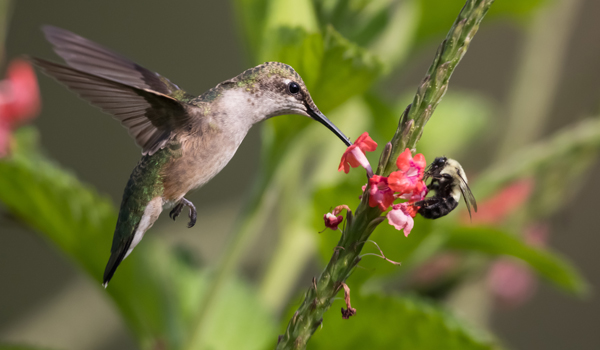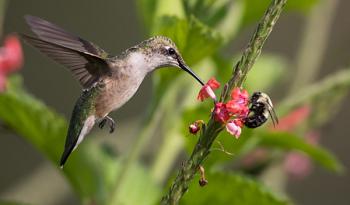Where Are the Birds and the Bees Going?
Can you imagine a world without bees? You probably love honey and the beautiful flowers bees pollinate. Now imagine a world without birds. That’s a tougher one to think about. Imagine visiting a silent countryside or woodland, or even a silent backyard. Imagine not seeing them flying above youor building their nests in spring. Could this be a vision that our descendants will see? It could be.The use of pesticides is not only killing insects, but the birds who eat them and bees who get pollen from flowers. Even the flowers you buy at stores may be treated with pesticides that are found in the entire plant structure. How has this happened?
Just prior to WW II, a new chemical called DDT was discovered and found to be effective in killing the mosquitos that caused malaria and typhoid fever. Because these diseases were killing soldiers during the war, the military seized on the opportunity to use this newly discovered chemical. Now fewer soldiers died from disease, and the ones that came home alive were showing no ill effects from their exposure. Farmers were ecstatic. Up until then they were having a terrible time controlling the insects that were destroying their crops. DDT was like a miracle for them and they began profusely spraying it over their crops, totally oblivious to the damage it was doing. They needed it, the soldiers weren’t sick, and the government approved it. Who wouldn’t jump at this chance to save their crops, their livelihood?
But in the 1940’s the dawn began to break about the dangers of DDT, and in 1947 the Federal Insecticide, Fungicide and Rodenticide Act, or FIFRA, was enacted, but this largely served to protect farmers and drug manufacturers from unscrupulous people seeking to get in on the action and had less to do with public health. The bill was passed without fanfare.
Enter Rachel Carson. Rachel was a marine biologist and environmentalist who began studying the effects of DDT on the environment, and in 1962 she released a book, Silent Spring, detailing the results of her research.Her book caught the attention of the government, who believed her conclusionsshowed enough merit to warrant further study, and the Environmental Protection Agency (EPA)was born.
DDT was subsequently banned all over the world except in countries where mosquito-borne illnesses present a significant threat, but then new types of pesticides proliferated to replace it, bringing with them more health issues, especially with neonicotinoids, or neonics. These chemicals are potent neurotoxins that affect sense of direction and smell and cause paralysis.Theyaren’t selective in choosing their victims, so many beneficial insects are destroyed, along with the birds and bees who eat the pollen and insects.
More red flags were raised, and in Europe and Canada, neonicswere banned, but not in the United States. Why? Is there a quid pro quo between the EPA, the government, and pharmaceutical companies? Limitations have been put on the concentration of neonics in agricultural products, but is that enough to save our wildlife?We can’t control what the government allows, but we can control what we use on our own lawns and gardens. Insecticides can be created usinghousehold ingredientssuch as garlic, onions, cayenne pepper, hot pepper flakes, liquid dish soap (without bleach), chopped tomato leaves, and apple cider vinegar. Additionally, neem oil, chopped tomato leaves, eucalyptus oil, citrus oil, and chrysanthemums can be used for the concoction. Mix them up, try these natural pesticides, and breathe easier knowing that you are part of the solution.
Comments
There are 0 comments on this post













